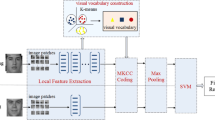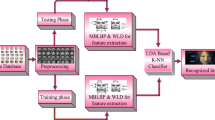Abstract
Due to the semantic gap between the insufficient facial features and facial identifying information, the single sample per person (SSPP) problem has always been a significant challenge in the field of facial recognition. To address this problem, this paper proposes a Self-Organizing Map (SOM)-based binary coding (SOM-BC) method, which extracts the middle-level semantic features by merging the SOM network with the Bag-of-Features (BoF) model. First, we extract the local features of the facial images using the SIFT descriptor. Next, inspired by human visual perception, we utilize a SOM neural network to obtain a visual words dictionary capable of reflecting the intrinsic structure of facial features in semantic space. Subsequently, a binary coding method is further proposed to map the local features into semantic space. Finally, we propose a simple but effective similarity measure method for classification. Experimental results on three public databases not only demonstrate the effectiveness of the proposed method, but also its high computational efficiency.










Similar content being viewed by others
Notes
The datasets analysed during the current study are available in http://vision.ucsd.edu/~leekc/ExtYaleDatabase/ExtYaleB.html, http://www2.ece.ohio-state.edu/~aleix/ARdatabase.html, http://vis-www.cs.umass.edu/lfw/
References
Belhumeur PN, Hespanha JP, Kriegman DJ (1997) Eigenfaces vs. fisherfaces: recognition using class specific linear projection. IEEE Trans Pattern Anal Mach Intell 19(7):711–720
Bodini M, D’ Amelio A, Grossi G, Lanzarotti R, Lin J (2018) Single sample face recognition by sparse recovery of deep-learned lda features. In: International conference on advanced concepts for intelligent vision systems, Springer, pp 297–308
Chan TH, Jia K, Gao S, Lu J, Zeng Z, Ma Y (2015) Pcanet: A simple deep learning baseline for image classification? IEEE Trans Image Process 24(12):5017–5032
Chen S, Liu J, Zhou ZH (2004) Making flda applicable to face recognition with one sample per person. Pattern Recognit 37(7):1553–1555
Deng W, Hu J, Guo J (2012) Extended src: undersampled face recognition via intraclass variant dictionary. IEEE Trans Pattern Anal Mach Intell 34(9):1864–1870
Deng W, Hu J, Zhou X, Guo J (2014) Equidistant prototypes embedding for single sample based face recognition with generic learning and incremental learning. Pattern Recognit 47(12):3738–3749
Ding C, Bao T, Karmoshi S, Zhu M (2017) Single sample per person face recognition with kpcanet and a weighted voting scheme. Signal Image Video Process 11:1213–1220
Dozono H, Niina G, Araki S (2016) Convolutional self organizing map. In: 2016 international conference on computational science and computational intelligence (CSCI). IEEE, pp 767–771
Georghiades AS, Belhumeur PN, Kriegman DJ (2001) From few to many: illumination cone models for face recognition under variable lighting and pose. IEEE Trans Pattern Anal Mach Intell 23(6):643–660
Gray R (1984) Vector quantization. IEEE Assp Mag 1(2):4–29
Gu J, Hu H, Li H (2017) Local robust sparse representation for face recognition with single sample per person. IEEE/CAA J Autom Sin 5(2):547–554
Huang GB, Mattar M, Berg T, Learned-Miller E (2008) Labeled faces in the wild: a database for studying face recognition in unconstrained environments. In: Workshop on faces in ‘Real-Life’ Images: detection, alignment, and recognition
Hui-xian Y, Yong-yong C (2016) Adaptively weighted orthogonal gradient binary pattern for single sample face recognition under varying illumination. Iet Biom 5(2):76–82
Kan M, Shan S, Su Y, Chen X, Gao W (2011) Adaptive discriminant analysis for face recognition from single sample per person. In: Face and gesture 2011. IEEE, pp 193–199
Kohonen T (1990) The self-organizing map. Proc IEEE 78(9):1464–1480
Li X, Song A (2011) Face recognition using m-msd and svd with single training image. In: Proceedings of the 30th Chinese control conference. IEEE, pp 3231–3233
Li Z, Imai Ji, Kaneko M (2010) Robust face recognition using block-based bag of words. In: 2010 20th international conference on pattern recognition, IEEE, pp 1285–1288
Li Y, Shen W, Shi X, Zhang Z (2013) Ensemble of randomized linear discriminant analysis for face recognition with single sample per person. In: 2013 10th IEEE international conference and workshops on automatic face and gesture recognition (FG). IEEE, pp 1–8
Lin J, Li JP, Lin H, Ming J, Wang Y (2008) Robust face recognition with partial distortion and occlusion from small number of samples per class. In: 2008 international conference on apperceiving computing and intelligence analysis. IEEE, pp 57–61
Liu F, Yang S, Ding Y, Xu F (2019) Single sample face recognition via bof using multistage knn collaborative coding. Multimed Tools Appl 78(10):13297–13311
Lu J, Tan YP, Wang G (2012) Discriminative multimanifold analysis for face recognition from a single training sample per person. IEEE Trans Pattern Anal Mach Intell 35(1):39–51
Lu H, Li Y, Mu S, Wang D, Kim H, Serikawa S (2017) Motor anomaly detection for unmanned aerial vehicles using reinforcement learning. IEEE Internet Things J 5(4):2315–2322
Lu H, Zhang M, Xu X, Li Y, Shen HT (2020a) Deep fuzzy hashing network for efficient image retrieval. In: IEEE transactions on fuzzy systems
Lu H, Zhang Y, Li Y, Jiang C, Abbas H (2020b) User-oriented virtual mobile network resource management for vehicle communications. In: IEEE transactions on intelligent transportation systems
Martinez AM (1998) The ar face database. CVC Technical Report 24
Pang M, Cheung YM, Wang B, Liu R (2019a) Robust heterogeneous discriminative analysis for face recognition with single sample per person. Pattern Recognit 89:91–107
Pang M, Cheung YM, Wang B, Lou J (2019b) Synergistic generic learning for face recognition from a contaminated single sample per person. IEEE Trans Inf Forensics Secur 15:195–209
Serikawa S, Lu H (2014) Underwater image dehazing using joint trilateral filter. Comput Electr Eng 40(1):41–50
Shen F, Shen C (2013) Generic image classification approaches excel on face recognition. arXiv preprint arXiv:13095594
Sikka K, Wu T, Susskind J, Bartlett M (2012) Exploring bag of words architectures in the facial expression domain. In: European conference on computer vision. Springer, pp 250–259
Singh J, Bello Y, Refaey A, Erbad A, Mohamed A (2020) Hierarchical security paradigm for IoT multi-access edge computing. IEEE Internet Things J 8(7):5794–5805
Sokolovska N, Hai NT, Clément K, Zucker JD (2016) Deep self-organising maps for efficient heterogeneous biomedical signatures extraction. In: 2016 international joint conference on neural networks (IJCNN). IEEE, pp 5079–5086
Su Y, Shan S, Chen X, Gao W (2010) Adaptive generic learning for face recognition from a single sample per person. In: 2010 IEEE computer society conference on computer vision and pattern recognition. IEEE, pp 2699–2706
Turk M, Pentland A (1991) Eigenfaces for recognition. J Cognit Neurosci 3:71–86
Vedaldi A, Fulkerson B (2010) Vlfeat: An open and portable library of computer vision algorithms. In: Proceedings of the 18th ACM international conference on Multimedia, pp 1469–1472
Vesanto J, Himberg J, Alhoniemi E, Parhankagas J (2000) Som toolbox for matlab 5, report a57. http://www.cis.hut.fi/projects/somtoolbox/S. Accessed Aug 2012
Wright J, Yang AY, Ganesh A, Sastry SS, Ma Y (2008) Robust face recognition via sparse representation. IEEE Trans Pattern Anal Mach Intell 31(2):210–227
Yang M, Van Gool L, Zhang L (2013) Sparse variation dictionary learning for face recognition with a single training sample per person. In: Proceedings of the IEEE international conference on computer vision, pp 689–696
Zhu P, Zhang L, Hu Q, Shiu SC (2012) Multi-scale patch based collaborative representation for face recognition with margin distribution optimization. In: European conference on computer vision Springer, pp 822–835
Zhu P, Yang M, Zhang L, Lee IY (2014) Local generic representation for face recognition with single sample per person. In: Asian conference on computer vision. Springer, pp 34–50
Acknowledgements
This work was partially funded by Natural Science Foundation of Jiangsu Province under Grant No. BK20191298, Fundamental Research Funds for the Central Universities under Grant No. B200202175, and Key Laboratory of Coastal Disaster and Protection of Ministry of Euducation, Hohai University, under Grant No. 201905.
Author information
Authors and Affiliations
Corresponding author
Additional information
Publisher's Note
Springer Nature remains neutral with regard to jurisdictional claims in published maps and institutional affiliations.
Rights and permissions
About this article
Cite this article
Liu, F., Wang, F., Ding, Y. et al. SOM-based binary coding for single sample face recognition. J Ambient Intell Human Comput 13, 5861–5871 (2022). https://doi.org/10.1007/s12652-021-03255-0
Received:
Accepted:
Published:
Issue Date:
DOI: https://doi.org/10.1007/s12652-021-03255-0




